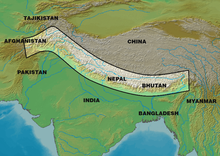Himalayan Rim
Geographically, it is surrounded by the Iranian Plateau in the west, Hindu Kush and Karakoram and Pamir ranges in the northwest, the Tibetan Plateau in the north, the Indochinese Peninsula in the east, and the Indian subcontinent in the south.
[3] By the early 16th century, Guru Nanak, the founder of Sikhism, brought the religion to the Himalayan Rim in his third udasi.
[4] During this time period, local Muslims, such as the Khache of Tibet, were participating in trans-Himalayan trade networks.
Thus, in 1816, the Treaty of Sugauli was signed, affirming the India-Nepal border and establishing better relations in the region.
[6] In postcolonial times, various conflicts have broken out along the Himalayan Rim, such as the Chinese annexation of Tibet and the Indo-China War of 1962,[7] and in general, there are significant tensions between various neighboring countries in the region as a result of border disputes.
